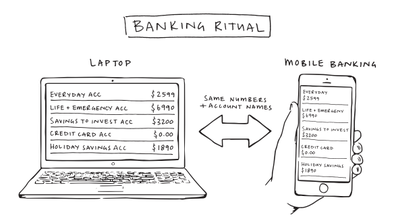2021 is the year to get your finances into shape.
Building financial stability is a lot like building a house. You need a solid foundation so that no matter what type of storm comes through, the house remains strong. When looking at our own financial wellbeing, our foundation is our budgeting and cashflow habits.
Many people tense up at the thought of a budget – will it end any sense of spontaneity? Can I ever have fun again? But it's important to remember that a budget isn't about depriving yourself, it's about creating simple, safe boundaries that allow you to spend within your own agreed limits so that you can get more out of life, guilt-free and in control.
Here, are my top tips for being financially fit on a budget:
Being ACCOUNTable
Utilising separate savings accounts in line with your financial goals makes it easier to track progress and hit both short-term and long-term objectives. This is a great strategy for building emergency savings, deposit money, or a holiday fund.
I recommend four savings accounts, ideally all connected to the same banking institution so you can view them on one consolidated screen via an app (ensuring there are no excuses not to check your financial progress!)

Your first account is your everyday account. This is where your pay is deposited and all your daily, weekly, fortnightly and monthly expenses come out – rent, mobile phone payments, or gym membership expenses, for instance.
The second account is your "Life + $X Emergency Account" – this is your most important "lighthouse" account as it will always keep you out of trouble. This account is to help you stockpile your cashflow for any ad hoc expenses that are often forgotten until the bill arrives. These include utility bills, car registration and insurance.
However, built into this account is also your emergency savings. The "Life" component of the account acts as a financial float and the additional funds represent your emergency money.
For life's unexpected events
How much emergency money you need will depend on your situation. If you have several financial responsibilities such as children or pets, you will need more. I recommend thinking about your worst-case scenario, (such as being unable to work), and how much money you would need to keep your head above water. It isn't unrealistic to need up to $10,000-$20,000, or even more. There isn't a one-size-fits-all formula, so you'll need to decide on an amount you feel comfortable with.
This money will slowly grow and will sit in your "Life + $X Emergency Money Account" where the "X" is replaced with your emergency money figure in the account nickname.
The third account allows us to have a little more fun – your Lifestyle Account – where you're able to safely allocate a certain amount each month towards an exciting goal such as a holiday savings, new car or even a deposit for a home.
Finally, the fourth account is a financial goal account. Here, you can allocate a certain amount of money to help achieve a financial goal, such as paying off debt or even preparing for retirement. It is the account where you start to put money aside (even if it is only a few dollars) and you have the intention to do something with those funds that will benefit your long-term financial wellbeing.
"Goal setting is key. Having clarity on your short, medium- and long-term objectives will put you in a better position to achieve them," says Liana Cauchi, senior financial adviser at ANZ.
Cashflow 101
The final step is to work out your cashflow allocation. Say I earn $5,000 per month after tax and find my monthly expenses equal $2,400, I would always keep this amount in my account when I get paid.
The remaining $2,600 needs to be split across my other three accounts. If I was starting from scratch, I would recommend focusing on building my emergency money as a priority. Should I ever withdraw this emergency money, I would always prioritise replacing these funds.
Once I have achieved my savings goal, only then would I start allocating my newly available $2,600 across the three accounts. This can be done any way you wish, but should match any deadlines that you have for your accounts, such as $2,000 for a holiday within 10 months.
It may take a bit of patience and practice initially, and you will need to review your accounts regularly, but ultimately, you'll feel in control of your financial wellbeing!
Get on top of your money with the ANZ Financial Wellbeing Challenge. Set a savings goal, manage your spending and find out your Financial Wellbeing Score, all with the help of ANZ.
This article was written by Canna Campbell, published by Nine and sponsored by ANZ as part of an arrangement between ANZ and Nine. Except where expressly stated, all views and opinions expressed in this article are Canna Campbell's. ANZ does not endorse or approve any of the views, opinions or advice expressed in this article. Advice does not take into account your personal needs, financial circ*mstances or objectives. Consider if right for you.